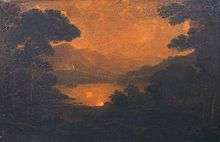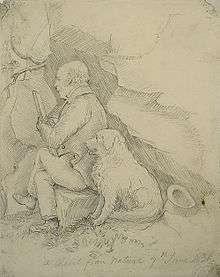John Thomson of Duddingston

by Henry Raeburn


John Thomson FRSE (1 September 1778 – 28 October 1840) was a Scottish minister and landscape painter. He was the minister of Duddingston Kirk from 1805 to 1840.[1]
Early life
The youngest of eight children, Thomson was born in the manse at Dailly, Ayrshire, the fourth son of the local parish minister. From an early age, he displayed an aptitude for drawing and painting and, inspired by the Ayrshire countryside, developed a love for landscape painting. In 1791 he enrolled at Glasgow University to study law and theology, and in 1793 he transferred to Edinburgh University to continue his studies for the ministry. Whilst there, he met many people who were prominent in Edinburgh artistic circles, including Walter Scott, and Alexander Nasmyth, the latter of whom who gave him art lessons.
After graduating, Thomson returned to Ayrshire and was licensed as a preacher of the Gospel, and subsequently ordained as minister of Dailly in 1800. He later moved to Duddingston near Edinburgh and became the most famous minister of the local Kirk, holding the post from 1808 to 1840. Whilst at Duddingston a very fine portrait of him was painted by Robert Scott Lauder who married Thomson's daughter Isabella in 1833.
Later career
Thomson had a studio at the foot of the manse garden on the shore of Duddingston Loch. Later, this was replaced by Duddingston Tower, a structure designed for Duddingston Curling Society in 1825 by William Playfair. The Society used the ground floor as their clubhouse, and Thomson used the upper floor of the tower, known today as "Thomson's Tower", as his studio.
The move to Duddingston allowed him to renew his acquaintances with men of influence in artistic circles and develop his art. Like his early teacher, Naysmith, Thomson believed in working outdoors, observing directly from nature. Influenced by the techniques of Rosa, Lorrain, Poussin, Raeburn and renowned English landscape artist Turner, he developed a broad Romantic style, and became a landscape artist with an established reputation. This allowed him to augment his small stipend and become quite wealthy through the sale of his paintings.
In addition to Scott, Naysmith and Raeburn, Thomson was friendly with writer and fellow amateur artist, Thomas Dick Lauder, and such was Thomsons reputation that in 1818 he entertained Turner at his studio, who is said to have remarked of the outlook over the Loch: "By God sir, I envy you that piece of water." [2] Thomson went on to collaborate with Turner in producing engravings to illustrate Walter Scott's Provincial Antiquities and Picturesque Scenery of Scotland, published in 1826.
Recognising his talent, Thomson's congregation nominated him to become a member of the Association of Artists in Edinburgh. He went on to receive honorary memberships of the Royal Institution for the Encouragement of the Fine Arts in Scotland and the Royal Scottish Academy. Thomson died at Duddingston in 1840, having spent forty-one years in the ministry.
Anecdotes
- In addition to being known for his landscape paintings, Thomson is often credited with giving rise to the famous Lowland Scots adage "We’re a' Jock Tamson’s bairns", which as early as 1847 was described as "an expression of mutual good fellowship very frequently heard in Scotland." However, there is some evidence that it may predate John Thomson, and there is also a Scottish Gaelic version.
- One version attributing the origin of the adage to Thomson is that his first wife died after they had five children, he then married a widow who already had five children, and this second marriage produced another four children. When his wife then made introductions to visitors and tried to explain which family the various children belonged to, Thomson would interrupt her with the statement that "They're a' Jock Thomson's bairns".[3]
- To ensure privacy to paint in his studio, Thomson named the Tower "Edinburgh", in order that casual visitors to the Manse could be informed by his staff that he was unavailable, as he had gone to "Edinburgh".[4]
- Duddingston Loch has a long historical connection with curling and skating and is the setting for the iconic painting, The Skating Minister, by Thomson's artistic acquaintance, Henry Raeburn. The subject of the painting is not Thomson however, but Robert Walker, minister of the Canongate Kirk.
References
- ↑ Waterston, Charles D; Macmillan Shearer, A (July 2006). Former Fellows of the Royal Society of Edinburgh 1783-2002: Biographical Index (PDF). II. Edinburgh: The Royal Society of Edinburgh. ISBN 978-0-902198-84-5. Retrieved 22 December 2011.
- ↑ http://webcache.googleusercontent.com/search?q=cache:Lb9_CdpK8agJ:www.lifestyle.scotsman.com/outdoors/justphenomenal_specific.cfm%3Farticleid%3D223+%22Reverend+John+Thomson%22+Raeburn&hl=en&gl=uk&ct=clnk&cd=2
- ↑ http://www.dailly-parish.co.uk/localhistory/local_notables/johnthomson/johnthomson.htm
- ↑ http://www.fortunecity.com/athena/exercise/2492/DUDDINGSTONKIRK/id18.htm
External links
-
 "Thomson, John (1778-1840)". Dictionary of National Biography. London: Smith, Elder & Co. 1885–1900.
"Thomson, John (1778-1840)". Dictionary of National Biography. London: Smith, Elder & Co. 1885–1900. - John Thomson on the Gazeteer for Scotland
- John Thomson on Electric Scotland
- John Thomson at the Tate Gallery
- Dailly community website